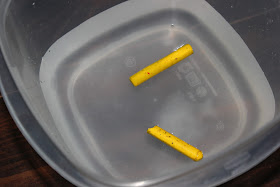Earth's Oceans
Read:
Pages 7-9 in Oceans
by
Johanna Rizzo.
Discuss:
Genesis
1:9-10, “And God said, “Let the water under the sky be gathered
into one place, and let dry ground appear.” And it was so. God
called the dry ground “land”, and the gathered waters He called
“seas”. And God saw that it was good.” God created the land
and water by speaking them into existence. Look at your globe and
notice how much of the earth is covered with water. The water covers
over half of the earth. There are 4 oceans in the world lets look at
them.
Arctic
Ocean - an ocean around the North Pole, bordering northern Europe,
Asia and North America. It is the smallest ocean. (to the north of
the US.)
Atlantic
Ocean - an ocean bordering western Europe, western Africa,
Antarctica, and eastern North and South America. (to the east of the
US.)
Indian
Ocean - an ocean bordering eastern Africa, southern Asia, western
Australia, and Antarctica.
Pacific
Ocean - an ocean bordering eastern Asia, northeastern
Australia, Antarctica, and western North and South America. It is the
biggest ocean. (to the west of the US.)
Pacific Ocean
J playing in the Pacific Ocean.Pacific Ocean
J jumping the waves with Grandpa.
Playing in the ocean some more.
See the dolphin fins in the top right corner of the ocean.
Map
Skills
Locate and label the following areas on your map or globe:
Atlantic
Ocean
Pacific
Ocean
Arctic
Ocean
Indian
Ocean
Europe
Asia
Africa
Australia
North
America
South
America
Antarctica
North
South
East
West
Find an example of these geographical features and mark them on your
map:
Island
Inlet
Bay
Peninsula
Man–made
Canal
Identify Oceans
We used the Identify Oceans printout to learn more about Earth's Oceans.
Addition of Double Digits
J practiced his Addition of Double Digits on this fun seahorse printout.
Sea
Water Experiment
Materials:
- Crayon
- Cup of water
- Salt Pot
- Stove (parental supervision)
Directions:
- Place a crayon in two cups of water. Does it sink or float?
- Change the density of the water by adding salt. Stir in one tablespoon of salt at a time. Then see if you can float a crayon upon it. How much salt did it take?
- Now, boil your water with the lid on the pot. Did salt crystals form on the side of the pan? Did the water condense (make drops) on the lid?
- Did the water on the lid still have salt in it? Why or why not? How would you distill sea water (remove the salt) to make it drinkable?
Ocean
Poem
Write
a poem about the sea. Start by using vivid describing words:
1.
Describe the sounds:
________________________________________________________________
2.
Describe the smells:
________________________________________________________________
3.
Use interesting words to describe the movement of the waves:
________________________________________________________________
4.
Can you think of words to explain a tide?
________________________________________________________________
5.
Describe the changes you see, the storms, the currents, and the
colors:
________________________________________________________________
6.
Use vivid descriptions for the way that sea creatures move. (For
example: some dart and dash, others scuttle, some slither and some
creep):
________________________________________________________________
7.
Use your answers above to write a poem about the ocean:
________________________________________________________________
________________________________________________________________
________________________________________________________________
________________________________________________________________
________________________________________________________________
________________________________________________________________
Ocean Art
Materials:
- Ocean Animal Printouts
- Blue Paint
- Paintbrush
- White Paper
- Sand
- Crayons
- Scissors
- Glue
- Small Shells
Directions:
1. Paint the entire piece of white paper with blue paint.
2. While the paper is still wet, add sand to the bottom part of the paper.
3. Color and cut out ocean animals.
4. Glue the ocean animals onto the ocean picture.
5. Glue shells to the bottom of the paper.
Ocean Spelling
J practiced spelling ocean animals with pages 11 & 15 of part 2 of this Ocean Pack.
In the Ocean
J made an Ocean Accordion Book with this free download.
Colorful Ocean
Materials:
- Crayons
- White Paper
- Tooth Pick
Directions:
1. Fill the whole paper with different bright colors.
2. Cover the colors with black crayon, press hard and cover the whole paper.
3. Use the tooth pick to draw pictures of ocean animals in the black.
Listening Skills
We used page 3 of part 3 of this Ocean Pack to work on J's listening skills. I read the directions once and he followed the directions.
Ocean Wonders Puzzle
J put together his Ocean Wonders Floor Puzzle on this day.
Drawing a Marlin
J drew a Marlin on page 16 from It's Fun to Draw Sea Creatures by Mark Bergin.
Ocean Patterns
J made patterns by coloring page 2 of part 3 of this Ocean Pack . I told him to do patterns that had 3 or more colors.



















I just found you! and this is so what I needed! Life saver!!
ReplyDeletegreat, glad I could help :)
ReplyDelete